Making Brand Decisions that Help Your Branding
The days following Thanksgiving hold the title as some of the busiest of the year for shoppers. There are millions of looking to purchase and billions of dollars being spent. For some brands, this year was different – instead of focusing on sales or discounts, they found the opportunity to make brand statements bigger than what they have on sale.
A number of big brands, including T.J. Maxx, Marshall’s, HomeGoods, DSW, Apple, Nordstrom and Sam’s Club, bucked the trend of opening their doors on Thanksgiving evening, making a point to emphasis their brands’ importance on valuing time with family. Of these, one brand’s strategy to tie the decision back to their brand attributes made it stand out among this group.
REI took the holiday weekend to make a big statement about their brand– closing their doors on both Thanksgiving Day and Black Friday.
They encouraged their would-be-shoppers to “Opt Outside,” in alignment with the brand’s equity in adventure. REI wanted to show a different way to spend the weekend, encouraging potential shoppers to enjoy the great outdoors, a concept that fits in line with their overall brand strategy.
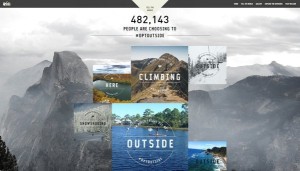 This branding effort took many forms beyond the initial announcement. For instance, REI made a website available where over 1 million people posted pictures of their outdoor adventure and created the hashtag #OptOutside to further encourage sharing their . The CEO of the company wrote a heart-felt message to shoppers and employees about the company’s values and the brand’s stance on enjoying the outdoors, including the line “a life outdoors is a life well lived.” Again, their messaging and strategies showed consumers that the REI brand is a lifestyle, and goes beyond their name and logo.
This branding effort took many forms beyond the initial announcement. For instance, REI made a website available where over 1 million people posted pictures of their outdoor adventure and created the hashtag #OptOutside to further encourage sharing their . The CEO of the company wrote a heart-felt message to shoppers and employees about the company’s values and the brand’s stance on enjoying the outdoors, including the line “a life outdoors is a life well lived.” Again, their messaging and strategies showed consumers that the REI brand is a lifestyle, and goes beyond their name and logo.
And while they didn’t process any online orders on Black Friday, customers still shopped on their site - SimilarWeb reported that REI saw a 10 percent increase in online traffic on Thanksgiving, and a 26 percent lift on Black Friday. Did the lift overcome dollars that could have been made in-store? Who knows? But the effect on the brand I believe will be lasting.
The greatest lasting impression may be on the brand’s equity in outdoor adventure. If there were some who questioned the brand’s true passion for the outdoors, that equity was cemented by their bold move on Black Friday.
The decision was a reminder to REI shoppers that the products sold through REI have consistent value and demand a premium. REI isn’t looking to push volume out the door and compromise value perceptions it has built year-round. Not participating in Black Friday, maybe more than anything, says that REI is different. They are a different kind of retailer, one less focused on revenue and more focused on experiences, especially experiences that are in line with their brand.
REI took the unorthodox route in its moves this past weekend, where it chose not to get caught up in the holiday hysteria. In doing so, they reinforced that sometimes what defines our brands and makes a lasting brand difference is not what we choose to do, but what we choose not to do. And the most successful of these brands don't just act in a vacuum - they act with a strategy that ties these decisions back to what their brand stands for, reinforcing the notion that they don't just walk the branding walk, but talk the branding talk.
Image Sources:
https://business.transworld.net/news/why-rei-wont-be-open-on-black-friday
https://newsroom.rei.com/multimedia/photos/holiday-2015/
Addison Whitney is a global branding firm with a passion for building strong brands.
To learn more about Addison Whitney, visit our website at AddisonWhitney.com, or contact us here.
10 Ways to Set Yourself Up for Rebrand and Brand Refresh Success
The end of the year is coming up, and looking back at your brand in 2015 you realize that something seems just a little… off. Sales weren’t what you wanted them to be, your brand awareness and public relations wins came few and far between, or maybe you’re seeing competitors in your space start to slowly take away market share.
As you take stock of all of the factors that go into an organization’s success, the strength of your brand may not be at the top of the list. But chances are, it should. Your brand is one of, if not the most powerful asset for your organization when it comes to presenting yourself to the consumer and staking your claim in the marketplace.
Going through a brand refresh or a total rebrand can be an intimidating and overwhelming experience, a strategic move many companies are hesitant to take. This doesn’t have to be the case. Here are 10 steps that will help ensure your brand refresh or rebrand will get off on the right foot:
1. Discuss plans and outline expected benefits with company leadership. Keeping the leadership teams involved early on in the process will help ease the transition, in addition to increasing buy-in from those in key decision-making positions.
2. Conduct market research to understand how the external audience perceives the brand. Your audience will be the primary guide to how the refresh/rebrand process will be received. Before you begin, find out where you stand with this group, providing a benchmark on where to begin.
3. Audit all sales and marketing materials to determine the scope and associated expense of a rebrand/refresh. Will your new brand need to be changed on everything from business cards to email signatures? Sometimes these lesser-known touch points can be overlooked and cause an inconsistent branding look, hindering your new brand’s success.
4. Identify the primary benefits associated with the brand. A rebrand/refresh doesn’t have to include changing every aspect of the brand. Find out what your audience feels are the areas that set your brand apart, and then determine which of these should be carried through and included in the new brand.
5. Identify all stakeholders and brand touch points to determine the appropriate timeline for a brand refresh/rebrand. Just like Rome, new brands aren’t built in a day. They take a process that must be calculated and depends on input from key stakeholders and the time necessary to ensure that all touch points are updated and are on brand.
6. Determine whether the changes are an evolution of the current strategy or a revolution calling for greater change. Rebranding or refreshing involves more than logo and name changes. It encompasses a brand strategy element as the driver of all subsequent moves. Is your new brand going to become an offshoot of your current brand strategy, or will it be taken to the next level and include a new outlook on what your brand strategy will be?
7. Set clear goals to measure the short- and long-term successes of the initiative. Before you start on the journey, set the markers to which you’ll measure the impact. Measurement is a vital part of determining whether the changes are putting your brand on the right path, or whether it’s time to alter the course.
8. Appoint focused, influential team members to a core project team to oversee the implementation process. The core project team will not only need to make decisions throughout the process, but will need to earn buy-in from across the company, especially from those on the leadership team.
9. Identify the ways in which the brand refresh/rebrand will impact each department. Some of the departmental impacts will come to light right away, but a truly successful new brand touches each area of business – make sure that they don’t come as a surprise, or have unexpected consequences on the brand or the business.
10. Create talking points outlining why the changes were necessary and the expected benefits to the company and customers. Especially if you have a lengthy history or have strong brand loyalists, there will be questions that come up in regards to the new brand. Be prepared to answer these with confidence and the ability to explain the positive benefits that will come from the rebrand/refresh.
Addison Whitney is a global branding firm with a passion for building strong brands.
To learn more about Addison Whitney, visit our website at AddisonWhitney.com, or contact us here.
Addison Whitney to Host Webinar: Evaluating Your Brand - Are You Due For A Refresh?
Has your company recently experienced change or growth? As companies and products evolve, your name, visual identity and positioning need to evolve as well.
Join Addison Whitney for a informative webinar on Wednesday, November 18th entitled: "Evaluating Your Brand: Are You Due for a Refresh?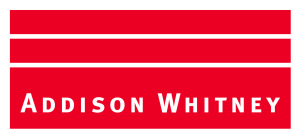
This webinar, hosted by Wendy Jacobs, Vice President of Addison Whitney West, will provide guidance how to evaluate your brand, and know if it's time for a brand refresh. We'll take a look at:
- Understanding when it's time for a brand refresh
- The opportunities it can bring
- How to create successful path to change
About the Speaker:
 As the leader of Addison Whitney’s Seattle office, Wendy works with our clients to drive brand strategy, brand name development, brand identity work and brand measurement efforts.
As the leader of Addison Whitney’s Seattle office, Wendy works with our clients to drive brand strategy, brand name development, brand identity work and brand measurement efforts.
After spending a successful 20 year career on the client side at Microsoft, Wendy brings a unique perspective and strong leadership to help each of her clients with their branding needs. Her years of experience will help provide attendees with a unique and in-depth look at their own branding strategy and how to take it to the next level.
Sign up here today!
3 Ways Social Media Can Benefit Your Brand's Image
There’s a very good chance that the first (and possibly only) interaction that your audience will have with your brand will come via social media. With the vast majority of consumers spending their time on these platforms, your social media presence could be the difference between becoming a brand that finds success and being just another brand that falls by the wayside.
How branding and social media interact is a topic that covers a number of different perspectives and points of information, but today we’re going to look at how you can impact and improve your brand’s image online.
Here are three ways that your brand strategy and social media strategy can work together for the benefit of your brand image:
1. Choose Wisely.
There are thousands of different social media platforms out there for brands to use, and that number seems to grow every day. It would be virtually impossible for a brand to even create accounts that serve all of these platforms, let alone be successful in any aspect. This is why the first step to integrating social media and branding should be to identify those specific platforms that best fit your brand’s image and brand strategy.
For instance, if you are a consumer brand with strong visual branding characteristics, then visually-heavy platforms like Instagram and Facebook will be the first stops on your social  media strategy. On the flip side, if your ideal consumer audience consists of a younger demographic, maybe LinkedIn isn’t the place to go.
media strategy. On the flip side, if your ideal consumer audience consists of a younger demographic, maybe LinkedIn isn’t the place to go.
2. Stay the Course.
Your brand strategy and branding efforts should include well-defined and relevant messaging, which should be present in all aspects of your social media work. This is not a place to try and break free of your what characteristics make up your brand – it’s actually the ideal place to further express your brand character.
This concept should expand to include all aspects of your brand, including your visual brand elements – your logos, images, etc. These are often the first point of contact with your brand, and as such should be formatted to fit the platform, consistent and on-brand across your entire social media presence. It’s not a good look when your Facebook profile picture is a partial image of your logo that doesn’t fit the image box or when you have images throughout your Instagram profile that have no connection with your brand.
Now, this doesn’t mean you can’t be creative or provide new and interesting ways to expressing your brand, but always be sure that you can connect it back to a core brand principle.
3. Think of the Big Picture.
This is an aspect of social media strategy that is often lost – it’s easy to get caught up on the post-by-post mindset, where each individual piece of content becomes its own strategy. There is often a lot of time and effort that goes into creating quality social media content (as it should be), but don’t lose sight of how your audience will connect that content with your brand.
Much like point number two, keep your brand’s overall principles and characteristics in mind and work to create content that doesn’t just show quality itself, but connects that associated quality back to what you want your brand to be.
Some of the best social media brands are the ones that follow these tips, but also find ways to put their own spin to them in order to create and post content that keeps your audience engaged and brings your brand more exposure (in the right way).
Addison Whitney is a global branding firm with a passion for building strong brands.
To learn more about Addison Whitney, visit our website at AddisonWhitney.com, or contact us here.
Short, Sweet and Straight to the Point - Communicating Your Brand Position Quickly and Efficiently
“If you can’t state your position in eight words or less, you don’t have a position” – Seth Godin
I'm the first to admit that my writing will most likely never be described as "concise." While I don't always mean to, I've definitely fallen victim to the "why you one word when you can use 10" school of writing now and again.
However, when it comes to defining and communicating your brand's core mission, you would be wise to follow the words of Mr. Godin - shorter is definitely better.
Short, sweet and straight to the point is not only a good piece of advice for your every day communication, but it should also be a building block to keep in mind when creating a brand position or defining brand values. We've all heard of the elevator speech used to quickly sell yourself to someone in the length of an elevator ride, and in brand strategy development, a brand elevator speech can get your name to the top of the consumer's mind quickly.
Highlighting the impact of efficient communications when discussing who your brand is and what it stands for serves a number of positive purposes, including ensuring that the audience knows that you actually know what those values are. When you start to ramble on and speak in circles, a doubt begins to surface regarding how sure about that topic the speaker is, and in the case of discussing your brand position, that doubt can be the difference between a strong successful brand and a brand that falls flat.
Additionally, having the ability to quickly and succinctly communicate this aspect of your brand shows a sense of buy-in to what you're speaking about. You don't need to add filler words to try and justify the positioning to yourself - each of the words used serve a purpose to the greater quote and each spot is valuable.
Additionally, your consumers are attenuated with countless brands and an abundance of brand messaging - so much, that it often gets overwhelming and the consumer begins to shut out the noise, looking for the one brand that can get their message across in the shortest amount of time. If your brand starts its strategy with the mindset of efficient communications, it will most likely translate that same concept into all aspect of your brand - from a quick and easy to remember brand name to a tagline that follows the same principles.
Eight words to sum up what your entire brand stands for - eight words to encompass the emotional foundation for your brand strategy. That's not a lot, but it's definitely something to shoot for.
Addison Whitney is a global branding firm with a passion for building strong brands.
To learn more about Addison Whitney, visit our website at AddisonWhitney.com, or contact us here.
Would you like a Minion Tic Tac? The Strategy of Brand and Consumer Product Tie-ins
This morning, my 2-year-old son asked for his milk in a “Toy Story” cup, after requesting last night that I serve him “Minions” applesauce as he ate dinner on his “Cars” plate.
Now, this is either a testament to how demanding toddlers can be, or (and for the purpose of this branding-focused blog, this is the path we’re going to take) a testament to the success brands have when creating ties with everyday products.
We’ve all seen the examples – everything from book bags and lunch boxes to toothbrushes and food items can be (and have been) branded in some way. For brands, it is an established way to get their brand strategy elements directly connected with their consumer audience. Even more desirable is when the consumers begin to associate that particular item with that brand, as seen by my son’s descriptions of his requested items.
One of the most successful examples in recent memory is the aforementioned “Minions” brand tie-in with products across the consumer spectrum. In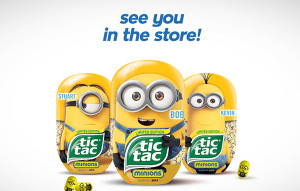 advance of the releases of both “Despicable Me 2” and their own “Minions” feature film, Universal Pictures took the chance to establish relationships with consumer brands that would spread the Minions to all corners of the consumer universe.
advance of the releases of both “Despicable Me 2” and their own “Minions” feature film, Universal Pictures took the chance to establish relationships with consumer brands that would spread the Minions to all corners of the consumer universe.
Partnering with brands such as Bounty, McDonald’s, Mott’s (the applesauce to which my son now only wants if there are Minions on the packaging), Chiquita – where it stuck Minion-themed stickers on over 500 million bananas - and many others, Universal has spent nearly $600 million in publicity, which is almost as impressive as the $593 million in ads and promotions delivered by these branding partners.
The yellow, goggled, gibberish-speaking characters have become an immensely powerful and popular brand extension for both Universal and their movie franchise – in fact, they’ve become a recognizable brand all their own. Not to mention, their namesake movie is on track to break the $1 billion mark in global sales, a number that undoubtedly owes some of its success to the overall branding efforts.
If there is one aspect of brand/product connection that can signal long-term brand success, it’s when the impact goes beyond the intended event.
For instance, the movie “Cars” was released almost 10 years ago (I couldn’t believe it’s been that long either), but its products still pepper the shelves 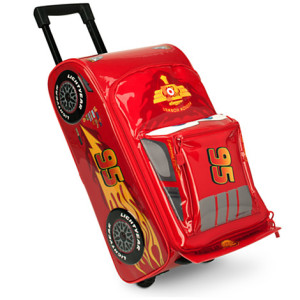 of toy stores and supermarkets today. Even kids who were years away from being born when the world was first introduced to Lightning McQueen and Tow Mater can recognize their characters immediately – all thanks to the existence of a successful brand/product relationship.
of toy stores and supermarkets today. Even kids who were years away from being born when the world was first introduced to Lightning McQueen and Tow Mater can recognize their characters immediately – all thanks to the existence of a successful brand/product relationship.
Not all relationships have these types of results, and the main reason for this is that they were disadvantaged by a weak initial brand. It’s not enough to create a brand strategy and associated brand elements and immediately put them on millions of cereal boxes and t-shirts – there must be a brand building period prior to the initial connection to give the products something to make them stand out.
Not to mention, the brand must be able to stand on its own, providing a positive connotation by association to the products. Much of the success of “Toy Story”-related products comes from the fact that the movies found widespread critical and audience acclaim, and gave us a set of timeless characters to which the products could focus upon. If the initial movie had bombed at the box office, it’s doubtful that Buzz Lightyear Halloween costumes would be seen trick-or-treating around the country.
So next time your child runs up to you in the store grasping a Mickey Mouse shampoo bottle or goes to sleep on their “Frozen” bed sheets, take the time to appreciate the branding efforts that went into making these connections and products possible.
Image Sources:
https://www.disneystore.com/lightning-mcqueen-rolling-luggage/mp/1379191/1000366/
https://www.brandchannel.com/2015/07/10/minions-movie-marketing-071015/
Addison Whitney is a global branding firm with a passion for building strong brands.
To learn more about Addison Whitney, visit our website at AddisonWhitney.com, or contact us here.
“Back to the Future” Branding
Sometimes, the best way to move forward is to take a look back. To look back at the best of what you have been in order to ensure the best that you will be.
For brands, this rings especially true when working through a rebrand or a brand refresh. Especially when the brand you have is one of the few “iconic” brands on the market, coming with a built-in nostalgia and fond memories of the branding of yesteryear.
However, this version of going back to the future comes with no worries of messing with the space-time continuum - in fact, tapping into a brand’s past can have positive impacts on its future.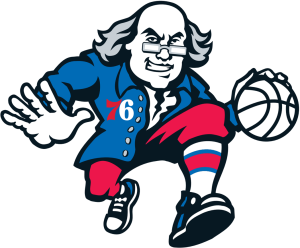
For instance, the Philadelphia 76ers basketball team has a two-pronged historic foundation to which it can build its brand refresh. Not only are they one of the oldest and most successful franchises in the NBA, but their home city also doubles as the birthplace of America.
So for their new branding efforts, they tapped into these two reservoirs of history and came up with a new brand that touches on both – for instance, their new uniforms are reminiscent of the ones the team wore in the mid-1970s, while they introduced a "dribbling Ben Franklin" alternate logo to go along with new television ads referencing the American Revolution – which was also the original influence for the team’s name.
Evolving a brand with a nod to its history is a great way to connect with your entire consumer audience – not only will you reach those who are excited about the rebranding efforts and the new aspects that come from it, but you’ll also have the automatic tie-in with those who remember fondly the “golden years” of your brand.
From a design standpoint, tapping into a well-regarded and well-received visual branding element from your past also prevents the chances of over-thinking a new design, where in an effort to develop something new and revolutionary comes out as off-base and not in line with your brand strategy. For these longtime brands, there’s a chance that the best design path is right there in the archives, and with a little touch-up, you can put forth a brand strategy and design that is both modern and historical.
Miller Lite, who had seen recent sales slides and was losing competitive share to its rivals in the U.S., looked to its past for what was originally meant to be a temporary brand shakeup, but has 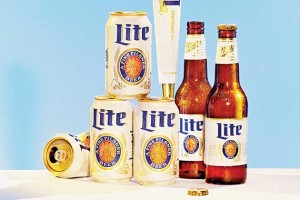 turned into a permanent new visual branding look. In conjunction with an advertising campaign centered around the release of the movie Anchorman 2 (set in the 1970s), the brand re-released its classic circa-1975 white Miller Lite can, complete with the retro logo design.
turned into a permanent new visual branding look. In conjunction with an advertising campaign centered around the release of the movie Anchorman 2 (set in the 1970s), the brand re-released its classic circa-1975 white Miller Lite can, complete with the retro logo design.
As for the result? Well, the numbers speak for themselves – the brand sold 32 million more cans during the campaign run compared to the same time the previous year, and has now expanded the nostalgic branding to its bottles and taps.
And don’t forget, just like every other aspect of branding, you have to follow the mantra of Tim McDermott, who is the 76ers CMO: “A brand isn’t just a TV spot. It is your soul, your DNA. It has to permeate through every fiber of the company.”
Image Sources:
https://espn.go.com/nba/story/_/id/12865822/sixers-score-ben-franklin-logo
https://www.bloomberg.com/bw/articles/2014-09-11/miller-lites-original-label-sales-boost
Addison Whitney is a global branding firm with a passion for building strong brands.
To learn more about Addison Whitney, visit our website at AddisonWhitney.com, or contact us here.
4 Ways Content Marketing Can Help Build Your Brand
Content marketing and branding should go hand-in-hand. However, there is often a disconnect between a brand strategy and the strategy around content creation, leading to a situation where an important aspect of brand cultivation is going untapped, without realizing the potential it has to move a brand forward.
But how can we bridge the gap between the two? Here are four ways content marketing can help build your brand:
- It Helps Define Who You Are
However your organization or brand decides to communicate what makes them unique and what makes them who they are, the message will be spread via your content marketing. Finding your niche and your expert area is vital in raising a brand’s reputability, and therefore where consumers will see it as the thought leader. Content marketing and content creation help you streamline your brand, and not waste time and energy trying to be everything for everybody.
- It Keeps Your Messaging Consistent.
A consistent content marketing messaging strategy is crucial to building both a strong brand and strong thought leadership credentials. Audiences and consumers appreciate when they can trust an organization, and when they have a sense of what to expect when interacting with them. Whether it’s an opinion piece on a new law or communicating a groundbreaking new best practice, when establishing a brand message that stays true to who the brand is, consistency is key.
- It Highlights the Best of the Best Within the Brand
Every brand and every organization has their “rock stars” – subject matter experts, innovative strategy developers, or any employee that stands out among the crowd. Putting these people at the forefront of a content marketing strategy and maximizing their exposure to the areas in which your company excels can drive positive attention that will in turn drive forward your brand and its thought leadership standing.
- It Helps Tell Your Brand Story
You can’t just create a brand and hope that your consumers and the industry will embrace it. Just the same, you can’t become and expert with a few unconnected blog posts. You have to develop your story – and then you have to know how to tell that story. For brands, the story can be anything from a theme behind your logos and name, or a strategy that links your branding efforts together. Whatever it is, your story needs to connect with the audience, and with a strong content marketing strategy, the story can be told that sets your brand apart.
Image Source:
https://startuphyderabad.com/wp-content/uploads/2015/07/contentmarketing.png
Addison Whitney is a global branding firm with a passion for building strong brands.
To learn more about Addison Whitney, visit our website at AddisonWhitney.com, or contact us here.
Brands Find Ways to Reinvent Themselves for Foreign Markets
There’s always been a mystery associated with foreign brands, but some have found ways to use their homegrown origins to give themselves a completely different brand image in foreign countries.
When Americans think of a nice beer, a wide range of local craft beers or major brands may come to mind, but one that is rarely considered is Pabst Blue Ribbon. This beer may be an American icon, but, ranking as one of the cheapest beers in the country, it is certainly not an American luxury.
However, this is not the case in China. Pabst Blue Ribbon has taken its authentic reputation as an American Icon and repositioned itself in Asian markets as a luxury beer. To an American who ha s never paid more than a dollar for a can of PBR, this may seem ridiculous. However, American exports often already connote luxury and high price point, so by emphasizing its American roots, PBR was able to ride on the wave of other authentically luxury exports from the United States.
s never paid more than a dollar for a can of PBR, this may seem ridiculous. However, American exports often already connote luxury and high price point, so by emphasizing its American roots, PBR was able to ride on the wave of other authentically luxury exports from the United States.
Pabst Blue Ribbon in China is sold in glass bottles, and the ribbon icon, while still maintained, is emblazoned on the bottle in gold rather than the standard blue. Pabst Blue Ribbon in Asian markets is also branded as “1844,” the year that is printed in small type on the traditional blue ribbon in the U.S.
Pabst Blue Ribbon isn’t the only company that has made a deliberate decision to change their brand image and positioning abroad, however.
General Motors has been met with massive success in Asian markets by branding their cars as the epitome of sturdy American dependability. This is another example of a  company modeling the image of their brand around values and characteristics already associated with America such as dependability and strength. Also, Pizza Hut, the quintessential American pizza joint, is a luxury dinner destination in China. The picture to the left shows the interior of a Pizza Hut in China. The Pizza Huts of China serve pizzas in cast iron skillets and offer elaborate fruit towers for dessert.
company modeling the image of their brand around values and characteristics already associated with America such as dependability and strength. Also, Pizza Hut, the quintessential American pizza joint, is a luxury dinner destination in China. The picture to the left shows the interior of a Pizza Hut in China. The Pizza Huts of China serve pizzas in cast iron skillets and offer elaborate fruit towers for dessert.
Branding Pizza Hut, PBR, and General Motors as quality, luxurious American exports may seem like a interesting practice to Americans, but American brands are not the only companies who deploy different brand images based on country. Heineken, for example, is the equivalent of PBR in the Netherlands, its country of origin. In the United States, however, Heineken is viewed as a quality beer.
This demonstrates that no domestic market is immune to the allure and mystique that are often attached to foreign brands, aspects which can help companies a with poor, or cheap, brand image at home reinvent themselves abroad.
Image Sources:
https://www.newyorker.com/news/letter-from-china/pardon-me-would-you-have-any-pabst-blue-ribbon
https://www.globalpartnersmba.com/real-chinese-food/
Addison Whitney is a global branding firm with a passion for building strong brands.
To learn more about Addison Whitney, visit our website at AddisonWhitney.com, or contact us here.
Gaining Brand Trust in a Share Economy
Today's post comes from guest blogger Caroline Lewis, Brand Strategy Intern at Addison Whitney
In the next 24 hours, nearly 1 million people around the globe will get in a stranger’s personal car using Uber. Over 800,000 will rent accommodations from private individuals with the help of Airbnb. Another 10,000 will lease a place for their pets to stay in someone’s home through DogVacay, and 10,000 more will hand their car keys over to an unfamiliar person using the car-sharing service, RelayRides.
Facilitated by smart phones and the internet, trusting consumers and the companies they use are considered part of the rapidly-growing “share economy,” which offers individuals the ability to exchange resources in a manner that would have been considered foolhardy just a few years ago.
The big question is: why are people placing so much trust in strangers?
This shift in consumer behavior is not caused by a business model trend, but a transformation of our society in the digital age. The economic effects of the global financial crisis of the 2000s have collided with the rise of social media, creating a culture in which we are not only driven by a desire to capitalize on unused resources, but also more open to the idea of sharing, even with complete strangers. This change has fueled an industry in which transactions rely on mutual trust and the exchanging of resources in a manner that benefits the common good.
The success of the share economy lies in how its brands cultivate trust. These brands focus their efforts on making consumers feel that they are interacting with people they can get to know, even if it is through the relative anonymity of the Internet.
Customer comments and ratings dominate web pages, creating atmospheres of credibility and trust between consumers and the brands. Many companies, such as Lyft (a transportation service similar to Uber), Airbnb, and RelayRides, recommend that users offering services connect their accounts to social media. Social media profiles reflect, at least in part, our real identities, and are therefore instrumental in building a more human persona, a strength for any brand.
The result has not only catapulted brands in the share economy space to booming success, but also changed the way that we view the strangers we interact with. Consumers are aware that they are 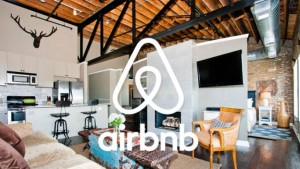 collaborating with real, individual people, creating a connection between brand, representative, and consumer unique to the share economy.
collaborating with real, individual people, creating a connection between brand, representative, and consumer unique to the share economy.
An Uber driver differs very little from a taxi driver in that both arrive to simply transport you to your destination. However, Uber’s consumers generally report feeling safer and more comfortable, and they are more likely to talk with drivers and sit in the front seat (or dance and sing with the driver, as seen here). With RelayRides, renters must meet the car owner to receive their keys. When RelayRides implemented this policy, satisfaction increased 40%, and users were more likely to keep the cars clean and return them on time. Interactions are between familiar faces, not complete strangers, and are beneficial to the brands, companies and individuals involved.
What does this mean for your brand?
Big or small, trust is essential. Consumers and customers are looking for innovative ways to get things done and want to trust the source – we see it in the share economy business trend, garden-to-table food trend, and home-schooling education trend. Build trust with your audience. Share feedback openly, let consumers get to know your brand ambassadors, salespeople, and customer service representatives in a real way. Let consumers be a part of the brand.
Image sources:
https://www.nytimes.com/2012/12/03/technology/app-maker-uber-hits-regulatory-snarl.html?_r=0
https://www.foxnews.com/travel/2015/04/22/10-things-need-to-know-about-airbnb-before-book/
Addison Whitney is a global branding firm with a passion for building strong brands.
To learn more about Addison Whitney, visit our website at AddisonWhitney.com, or contact us here.






